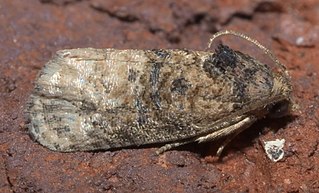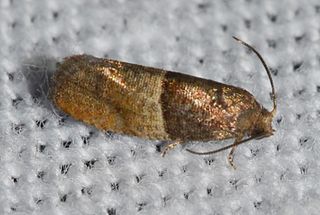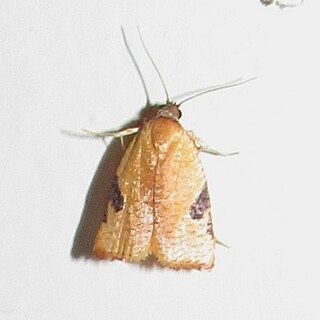
Amber is fossilized tree resin. Examples of it have been appreciated for its color and natural beauty since the Neolithic times, and worked as a gemstone since antiquity. Amber is used in jewelry and as a healing agent in folk medicine.

Theridiosomatidae, commonly known as Ray Spiders, are a family of araneomorph spiders first described by Eugène Simon in 1881. The family includes 137 species divided between 20 genera. They are most recognizable for their construction of cone-shaped webs.

Dominican amber is amber from the Dominican Republic derived from resin of the extinct tree Hymenaea protera.

Corticivora is a genus of moths belonging to the subfamily Olethreutinae of the family Tortricidae.

Ecdytolopha is a genus of moths belonging to the subfamily Olethreutinae of the family Tortricidae.
Karacaoglania is a genus of moths belonging to the subfamily Olethreutinae of the family Tortricidae.

Larisa is a genus of moths belonging to the subfamily Olethreutinae of the family Tortricidae. It contains only one species, Larisa subsolana, which is found in North America, where it has been recorded from Alabama, Florida, Georgia, Illinois, Indiana, Kentucky, Maine, Maryland, Massachusetts, Minnesota, Mississippi, Missouri, New York, Ohio, Oklahoma, Ontario, Quebec, South Carolina, Tennessee, Texas, Virginia, and West Virginia.
Procoronis is a genus of moths belonging to the subfamily Olethreutinae of the family Tortricidae.
Bhagwantolita is a genus of moths belonging to the family Tortricidae.

Cuproxena is a genus of moths belonging to the family Tortricidae.
Eucosmocydia is a genus of moths belonging to the family Tortricidae.

Gymnandrosoma is a genus of moths belonging to the family Tortricidae.
Pseudopammene is a genus of moths belonging to the family Tortricidae.

Spatalistiforma is an extinct genus of moths belonging to the family Tortricidae. It contains only one species, Spatalistiforma submerga, which was described from Baltic amber.
Statignatha is a genus of moths belonging to the family Tortricidae.
Stephanopyga is a genus of moths belonging to the family Tortricidae.
Talponia is a genus of moths belonging to the family Tortricidae.
Commoneria is a genus of moths of the family Tortricidae.
Macrocydia is a genus of moths of the family Tortricidae.
The La Toca Formation is a geologic formation in the northern and eastern part of the Dominican Republic. The formation, predominantly an alternating sequence of marls and turbiditic sandstones, breccias and conglomerates, is renowned for the preservation of insects and other arthropods in amber, known as Dominican amber. The formation is dated to the Burdigalian to Langhian stages of the Miocene period.








